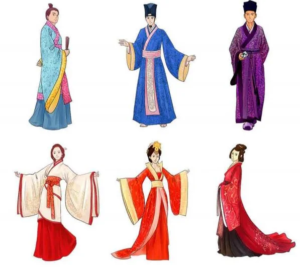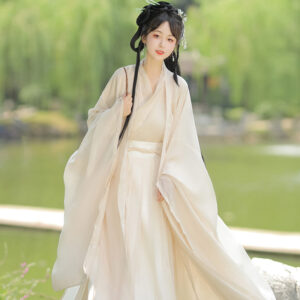

Hanfu accessories are rich in symbolism and cultural significance, reflecting the social hierarchy, personal virtues, and spiritual beliefs of ancient China. Here’s an overview of the historical meanings associated with various Hanfu accessories:
1. Hairpins
- Symbol of Coming of Age: Hairpins were significant for young women, particularly during the Zi ceremony, which marked their transition into adulthood. The choice of material (gold, silver, jade) and design conveyed messages about the wearer’s social status and virtues.
- Design Motifs: Common motifs included phoenixes and lotus flowers, symbolizing good fortune and purity.
2. Jewelry
- Necklaces and Pendants: Often made from jade or precious metals, these pieces were believed to offer protection and attract good fortune. Jade, in particular, was associated with moral integrity and purity.
- Bracelets and Rings: These items were not merely decorative; they were thought to ward off evil spirits. The materials used indicated the wearer’s social standing, with gold and jade signifying wealth.
3. Sashes and Belts
- Functionality and Decoration: Sashes secured Hanfu garments while also serving as decorative elements. The colors and patterns of sashes often held symbolic meanings; for example, red represented happiness and good fortune.
- Gender Indicators: The size and style of sashes could indicate the wearer’s gender and social status.
4. Pouches
- Practicality Meets Artistry: Pouches attached to sashes served practical purposes for carrying personal items but also displayed intricate embroidery that reflected the wearer’s taste and social rank.
- Symbolic Embroidery: Common designs included nature scenes or mythical creatures, each carrying its own significance.
5. Footwear
- Cultural Significance: Shoes worn with Hanfu varied by region and social class. They often featured intricate designs or auspicious symbols that indicated the wearer’s status.
- Materials Used: Footwear was typically made from silk or cotton, with more elaborate designs reserved for nobility.
6. Fans
- Functional and Aesthetic: Fans served both practical purposes (for cooling) and artistic expression. Often made from bamboo and silk, they featured paintings or calligraphy that conveyed cultural messages.
- Symbolic Meanings: Fans could symbolize elegance and grace, particularly in court settings.
7. Embroidered Items
- Sashes and Pouches: Embroidery played a crucial role in Hanfu accessories. Patterns often included dragons (authority), phoenixes (grace), and floral motifs (purity), each carrying specific meanings.
- Artistic Expression: The complexity of embroidery reflected the wearer’s artistic taste as well as their social status.
Conclusion
Hanfu accessories are not merely ornamental; they carry profound historical meanings that reflect ancient Chinese culture’s values, beliefs, and social structures. Each accessory tells a story about the wearer’s identity, status, and cultural heritage, making them integral to the overall significance of Hanfu attire in Chinese history.
Share this post
Facebook
Twitter
LinkedIn
Pinterest
Recent Posts


What were the key features of Hanfu during the Tang Dynasty?
October 24, 2024

How did Hanfu styles vary during different Chinese dynasties?
October 24, 2024

What accessories are typically worn with Hanfu?
October 24, 2024

How do you choose the right Hanfu for different seasons?
October 24, 2024

Newsletter
Subscribe for our monthly newsletter to stay updated
Popular Categories
Related Post
Sed aliquam, tortor et sodales malesuada, lorem leo luctus tellus, quis interdum eros nibh in nunc. Cras dignissim malesuada, lorem leo luctus

What are the winter hanfu called?
October 24, 2024

What were the key features of Hanfu during the Tang Dynasty?
October 24, 2024

How did Hanfu styles vary during different Chinese dynasties?
October 24, 2024

What accessories are typically worn with Hanfu?
October 24, 2024

